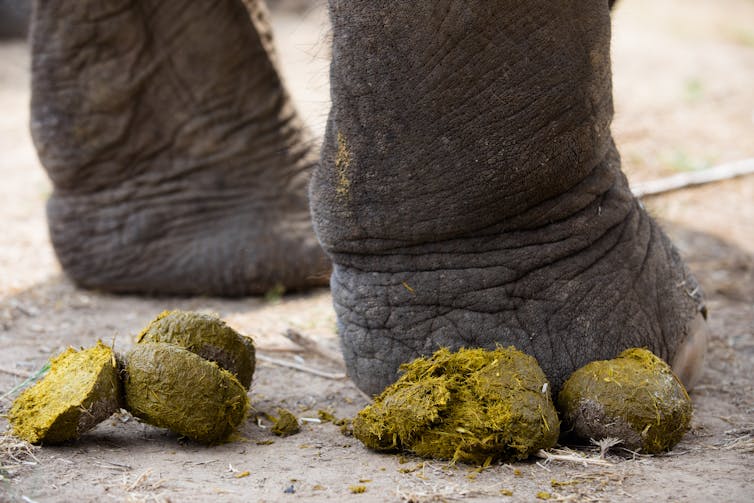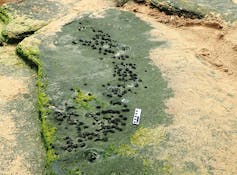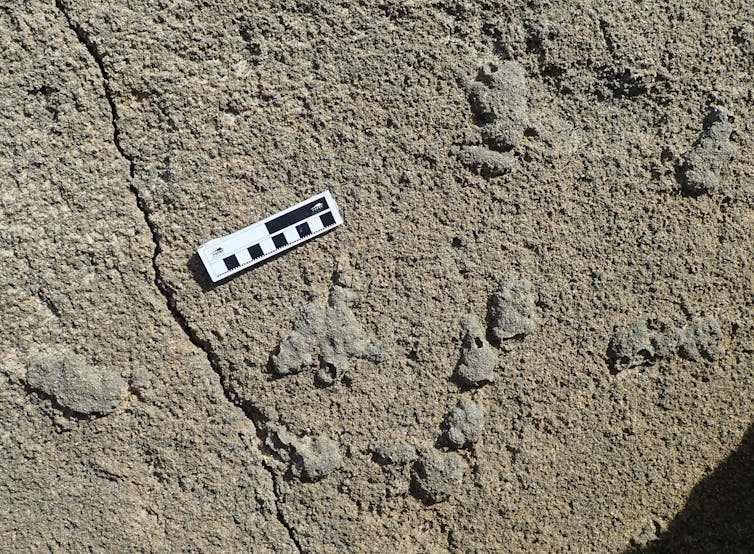
Charles Helm, Nelson Mandela University
Some people are annoyed when they encounter a fresh pile of dung while out on a walk in nature. Others are excited because it points to the recent visit of a particular kind of animal. But some scientists, myself included, may just be disappointed that the dung isn’t fossilised.
That’s because coprolites – fossilised scat – are palaeontological treasure troves. They can provide all sorts of information about the animal that deposited them, including the environment they lived in, what they ate and what the climate and vegetation were like.
Over the past decade, our research team has identified more than 300 vertebrate tracksites in aeolianites (cemented sand dunes) and cemented beach deposits on the Cape south coast of South Africa. They date back to the Pleistocene epoch, which started about 2.6 million years ago and ended around 11,700 years ago. But it took us a long time to realise that we shouldn’t just be looking for depressions (tracks) in the rock surfaces we study; we should also be on the lookout for raised features. These, it turns out, are often coprolites.
In a recent paper we describe a number of firsts. Our findings are the first of their kind from southern African aeolianites. We’ve also recorded the first known instances of coprolites belonging to a Nile crocodile, and to an African elephant. And we discovered a site where roaming elephants may have repeatedly disturbed small animals, probably mongooses or genets, that were answering the call of nature.
These discoveries, along with our previous research, combine to create a picture of an ancient landscape so scientists can better understand what came before. Looking back can also help us understand how and when things changed and what role factors like climate or the arrival of humans played in those changes.
The new sites
It took one particularly obvious example to alert us to what we had been missing by not considering coprolites as study material. On an aeolianite surface near the town of Knysna, about 500km from Cape Town, we spotted 130 dark nodules, between 2cm and 3cm in size. They formed a clear contrast to the much lighter surrounding surface, on which four tracks of a medium-sized bovid (probably an antelope called a bontebok) were evident.

The nodules were evenly spread over a distance of more than a metre, and a couple of them actually lay within the tracks. They were slightly flattened, suggesting that they had been lightly compressed by overlying dune layers while they were still malleable. A sample for dating from a nearby rock revealed that the site was around 76,000 years old.
It was our first coprolite site and it was an unprecedented finding. Bovid coprolites are extremely rare and an open-air site even more so. In southern Africa, coprolites are usually found in caves and rock shelters, in scavenger dens or archaeological deposits.
Also, we had luck on our side: the site is usually covered by metres of sand, and is only occasionally exposed.
Remarkably, close by we found a second site, but with very different characteristics. In this case we noted about 50 small tracks on a rock surface, on which were plastered about 30 raised features, many of which were cylindrical and hollow (characteristic features of some coprolites). In the low cliffs immediately above this surface we found similar coprolites in six layers in a vertical height of 2.6cm.

The evidence was clear: this was the site of a latrine (a place that an animal returns to repeatedly to defecate), which had been used for a substantial period of time. We could not identify the tracks to family level, as many small carnivorans leave tracks that are similar in size and shape. However, the nature of the latrine suggests that a genet or mongoose might have been responsible.
To add to the interest, deep elephant tracks were a common phenomenon on these same surfaces, leading us to imagine the latrine-maker having to dodge trampling by African elephants at indelicate moments.
More analysis needed
We found two other coprolite sites. One featured both African elephant tracks and coprolites – the first of their kind ever described. The other presented us with a crocodile coprolite right beside crocodile swim traces. This is the first ever record of a Nile crocodile coprolite; it was probably deposited underwater in a shallow lagoonal environment (crocodiles defecate either on land or in water).
We sent samples to university laboratories for different tests, including analysis of pollen and phytoliths (microscopic silica structures found in plants). Positive results would have aided in helping us interpret the Pleistocene environment and climate. Unfortunately, as often happens, all our coprolites were “sterile”, with no pollen or phytoliths to be found.
Our response is to keep trying: in 2022 we identified a number of other coprolites on the same coastline, including those of the extinct long-horned buffalo. These appear to have more internal structure, which augurs well for detecting phytoliths and pollen, and perhaps even evidence of bone fragments in the case of carnivores.
We hope that the samples we submit this time will deliver more positive results and will shed new light on the Pleistocene palaeoenvironment of coastal southern Africa.![]()
Charles Helm, Research Associate, African Centre for Coastal Palaeoscience, Nelson Mandela University
This article is republished from The Conversation under a Creative Commons license. Read the original article.

